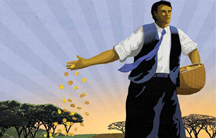Good Works
Finance & Development, December 2012, Vol. 49, No. 4
Can philanthropy and social entrepreneurship step in where official aid leaves off?

Charity and social entrepreneurship are nothing new. Andrew Carnegie, John D. Rockefeller, and the Vanderbilt family helped build the cultural infrastructure of the United States. Maria Montessori, John Muir, and Florence Nightingale were early social entrepreneurs in the fields of education, conservation, and public health.
But philanthropy is becoming an increasingly important part of the fabric of the global economy. While many governments contemplate pulling back, rich people are becoming more creative and strategic about their giving, and—if Bill Gates has his way—more generous and proactive.
Warren Buffett and Bill and Melinda Gates established The Giving Pledge in June 2010: a public commitment by some of the world’s richest people to give away at least half of their wealth, which in turn is meant to inspire more giving. To date, 81 billionaires have signed on, with Buffett alone pledging $37 billion.
Philanthropists are motivating their peers to do the same, and more. Donating fortunes and solving social problems today has taken on more cachet than passing on a huge inheritance or setting up posthumous monetary contributions.
U.S. universities, from Stanford to Georgetown, from Duke to Michigan, have established courses and even centers for the study of philanthropy. One approach is to study how to increase philanthropy, to get more funds for a project. Another is how to measure the effect—the impact—of philanthropy, to get more out of giving. But there are gaps in the research: limited data are available on private giving from countries other than the United States, though anecdotal evidence tells us that it is becoming more important. For example, Li Ka-shing, a Hong Kong–based businessman and billionaire, has given away over $1.5 billion and has pledged a third of his fortune—an estimated contribution of $9 billion—to charitable causes.
How much a person gives is one thing. How much change it effects is another. So philanthropists and academics are focusing on impact—what difference a contribution makes—and the best way to measure that impact.
Gates says the private sector underinvests in innovations because investors—those taking the risk—receive only a small portion of the returns. The state has traditionally interceded to meet needs that fall between the cracks, but Gates argues that governments—at least those democratically elected—don’t take the long view and are averse to risk.
That is where the philanthropist can fill the gap, with what Gates calls “catalytic philanthropy.” Government is good at finding a few likely winners, but philanthropy is good at supporting a lot of possible winners, increasing the odds that someone will find new solutions to any given social problem.
Companies are increasingly under pressure to contribute to society, or at least to appear to be doing so. Cynics argue that the corporate world does only what is necessary to help the bottom line. Large firms are setting up corporate social responsibility divisions and touting their products’ do-good qualities, in the realms of the environment, education, health, and culture. When pharmaceutical companies offer lifesaving medications such as AIDS or tuberculosis medications at reduced cost in poor countries or free up patents for generic production companies’ use, are they doing so to improve the lot of the sick and poor or under legal or political pressure?
Forbes, a magazine for and about the wealthiest people in the world, hosted a summit on philanthropy in June of this year, inviting 161 billionaires and nearly-theres to listen to keynote speakers Buffett, Steven Case, Gates, and Oprah Winfrey talk about how they could change the world. And the World Economic Forum now holds a session on social entrepreneurship—what Greg Dees defines as “pursuit of an innovative solution to a social problem.”
New York City is experimenting with creative financing to solve social problems—financing that not only measures but in fact depends on results. Goldman Sachs has invested in a “social impact bond” that is funding a nonprofit to design and run a program to reduce recidivism in the city by a target amount. If the project achieves that target, Goldman Sachs gets its money back; if it exceeds the target, the investment firm will profit. Losses are limited to one-fourth of the initial $9.6 billion investment, thanks to a subsidy by Mayor Bloomberg’s philanthropic foundation—demonstrating once again the importance of philanthropic risk takers.
In this issue of F&D, we look at the intersection of philanthropy, private investment, and social entrepreneurship: how people are finding better ways to solve society’s most pressing problems. ■


